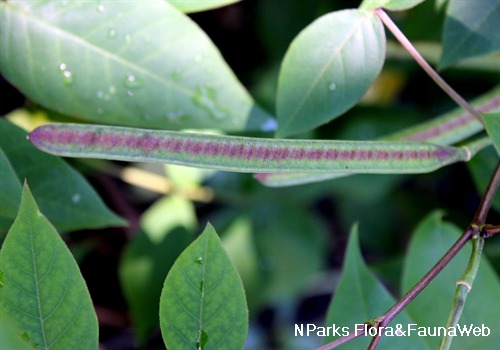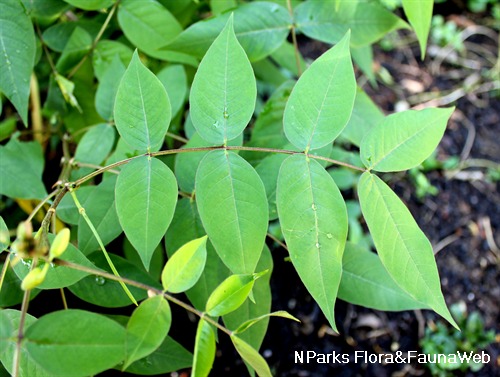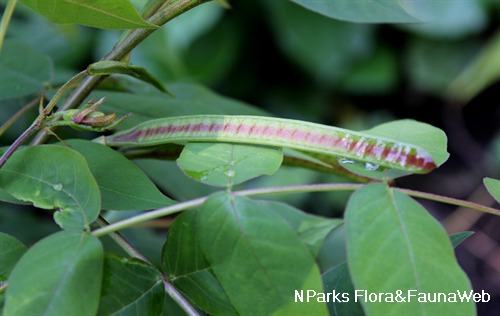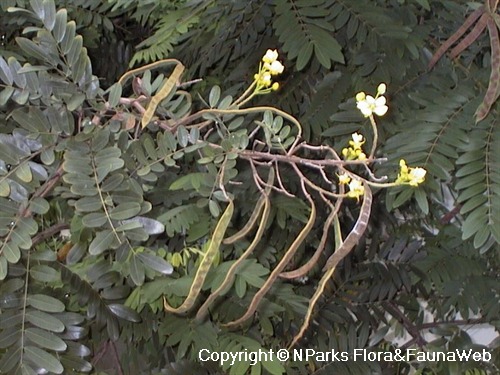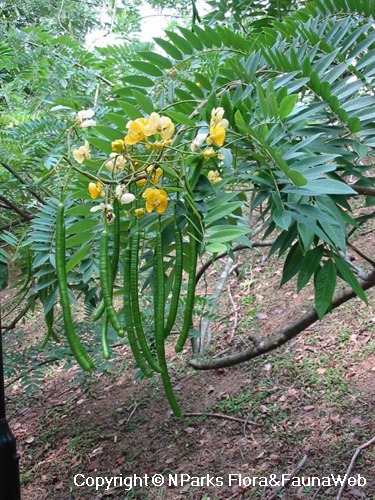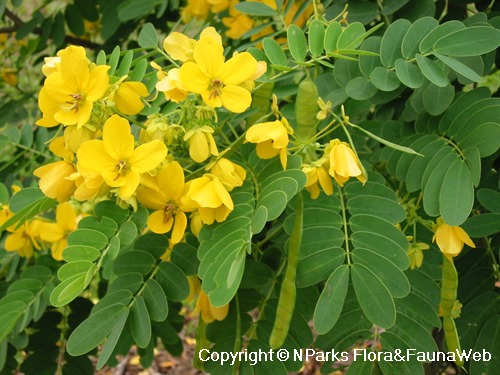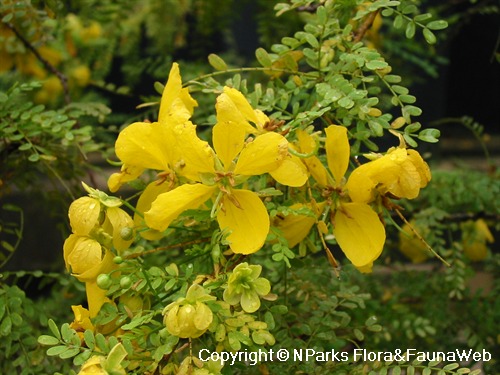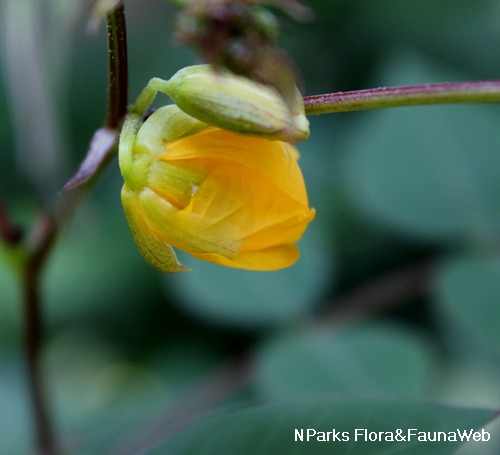
Back
Senna occidentalis (L.) Link
| Family Name: | Fabaceae (Leguminosae) |
| Synonyms: | Ditremexa occidentalis, Cassia occidentalis |
| Common Name: | Antbush, Coffee Senna, Negro-coffee, Stinkingweed, Arsenic Bean, Septicweed, Ponnavarai |
Name
Classifications and Characteristics
| Plant Division | Angiosperms (Flowering Seed Plants) (Dicotyledon) |
|---|---|
| Plant Growth Form | Shrub |
| Lifespan (in Singapore) | Perennial, Semi-Annual / Annual-Like, Annual |
| Mode of Nutrition | Autotrophic |
| Plant Shape | Open |
| Maximum Height | 0.5 m to 2 m |
Biogeography
| Native Distribution | Tropical America |
|---|---|
| Native Habitat | Terrestrial (Disturbed Area / Open Ground) |
| Preferred Climate Zone | Tropical |
Description and Ethnobotany
| Growth Form | Semi-annual or short-lived perennial subshrub, able to grow up to 1.5 - 2 m tall. |
|---|---|
| Foliage | Green leaves with 4 - 6 pairs of leaflets, petiole measuring about 3 - 4 cm long, leaflets measuring 4 - 10 cm long and 2 - 3 cm wide, ovate to oblong, upper surface glabrous, lower surface finely puberulous. |
| Stems | Open branching, young stems 4-angled, becoming rounded with age. |
| Flowers | 2 - 4 bright yellow flowers in short racemes, usually free- flowering. |
| Fruit | Fruit is a flattened, smooth and brown pod, measuring about 10 - 12 cm long and contains 30 - 40 seeds which are flat, measuring 3 - 4 mm wide. |
| Habitat | Can be found in waste places from sea level up to 1200 m. |
| Etymology | Genus Senna is derived from the Arabic name "sana", which refers to the laxative leaves and pods. Species occidentalis means from the Western world. |
| Ethnobotanical Uses | Edible Plant Parts : Edible Seeds Food (Herb or Spice): Seeds roasted and used as coffee substitute. Medicinal: Leaves have antibacterial, antifungal, anti-inflammatory, antiseptic and laxative properties. Leaves, roots and seeds used as general tonic for general weakness, as well as to treat fever, tuberculosis and liver complaints. |
Landscaping Features
| Desirable Plant Features | Ornamental Flowers, Fragrant (Foliage, Flowers) (Time Independent), Ornamental Seeds |
|---|---|
| Landscape Uses | General |
| Thematic Landscaping | Butterfly Garden, Naturalistic Garden |
| Usage Hazard - Cons | Toxic Upon Ingestion |
| Usage Hazard - Cons Remarks | Leaves and large amounts of raw seeds are toxic, implicated in poisoning or death of livestock. |
Fauna, Pollination and Dispersal
| Fauna Pollination Dispersal Associated Fauna | Butterfly Host Plant |
|---|---|
| Seed or Spore Dispersal | Abiotic (Explosive Dehiscence) |
Plant Care and Propagation
| Light Preference | Full Sun |
|---|---|
| Water Preference | Moderate Water |
| Plant Growth Rate | Moderate |
| Rootzone Tolerance | Fertile Loamy Soils, Well-Drained Soils |
| Maintenance Requirements | Moderate |
| Propagation Method | Seed, Stem Cutting |
| Propagule Establishment Remarks | Scarification (mechanical, acid, boiling) necessary for good seed germination. Scarified seeds germinate in 5-36 days. |
Foliar
| Foliage Retention | Evergreen |
|---|---|
| Mature Foliage Colour(s) | Green |
| Mature Foliage Texture(s) | Smooth, Raised / Sunken Veins |
| Foliar Modification | Stipule |
| Foliar Type | Compound (Even-Pinnate) |
| Foliar Arrangement Along Stem | Alternate |
| Foliar Shape(s) | Non-Palm Foliage (Ovate, Lanceolate) |
| Foliar Venation | Pinnate / Net |
| Foliar Margin | Entire |
| Foliar Apex - Tip | Acuminate |
| Foliar Base | Rounded / Obtuse |
| Typical Foliar Area | Microphyll ( 2.25cm2 - 20.25 cm2 ) |
Non - Foliar and Storage
| Stem Type & Modification | Woody |
|---|---|
| Root Type | Underground (Tap Root) |
Floral (Angiosperm)
| Flower & Plant Sexuality | Bisexual Flowers |
| Flower Colour(s) | Yellow / Golden |
|---|---|
| Inflorescence Type | Raceme |
| Flowering Period | Free-Flowering |
| Flowering Habit | Polycarpic |
Fruit, Seed and Spore
| Mature Fruit Colour(s) | Brown |
|---|---|
| Fruit Classification | Simple Fruit |
| Fruit Type | Dehiscent Dry Fruit , Legume / Pod |
| Seed Quantity Per Fruit | Numerous (>20) |
Image Repository
Others
| Master ID | 20701 |
|---|---|
| Species ID | 3353 |
| Flora Disclaimer | The information in this website has been compiled from reliable sources, such as reference works on medicinal plants. It is not a substitute for medical advice or treatment and NParks does not purport to provide any medical advice. Readers should always consult his/her physician before using or consuming a plant for medicinal purposes. |

